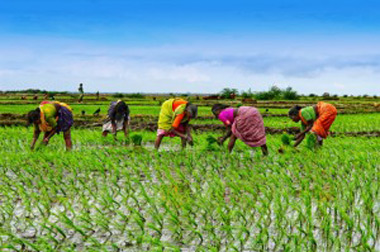Agricultural population growth marginal as nonagricultural
population soars
The global agricultural population - defined as individuals dependent
on agriculture, hunting, fishing, and forestry for their livelihood -
accounted for over 37 percent of the world's total population in 2011,
the most recent year for which data are available.
This is a decrease of 12 percent from 1980, when the world's
agricultural and nonagricultural populations were roughly the same size.
Although the agricultural population shrunk as a share of total
population between 1980 and 2011, it
grew numerically from 2.2 billion to 2.6 billion people during this
period.
|

The world's agricultural population grew from 2.2 billion to
2.6
billion people between 1980and 2011. |
Between 1980 and 2011, the nonagricultural population grew by a
staggering 94 percent, from 2.2 billion to 4.4 billion people - a rate
approximately five times greater than that of agricultural population
growth. In both cases growth was driven by the massive increase in the
world's total population, which more than doubled between 1961 and 2011,
from 3.1 billion to 7 billion people.
It should be noted that the distinction between these population
groups is not the same as the rural-urban divide. Rural populations are
not exclusively agricultural, nor are urban populations exclusively
nonagricultural. The rural population of Africa in 2011 was 622.8
million, for instance, while the agricultural population was 520.3
million.
Although the agricultural population grew worldwide between 1980 and
2011, growth was restricted to Africa, Asia, and Oceania. During this
period, this population group declined in North, Central, and South
America, in the Caribbean, and in Europe.
In 2011, Africa and Asia accounted for about 95 percent of the
world's agricultural population. In contrast, the agricultural
population in the Americas accounted for a little less than 4 percent.
Especially in the United States, this is the result of the development
and use of new and innovative technologies as well as the increased use
of farm machinery, chemical fertilizers, pesticides, and irrigation
systems that require less manual labor.
Population trends have varied widely for the world's leading
agricultural producers: China, India, and the United States. Between
1980 and 2011, the economically active agricultural populations of China
and India grew by 33 and 50 percent, respectively, due to overall
population growth. The economically active agricultural population of
the United States, on the
other hand, declined by 37 percent as a result of large-scale
mechanization, improved crop varieties, fertilizers, pesticides, and
federal subsidies - all of which contributed to economies of scale
and consolidation in American agriculture.
Although the world's agricultural population grew only marginally in
recent decades, global agricultural output increased dramatically.
According to the UN Food and Agriculture Organisation (FAO), global net
agricultural production increased by 112 percent between 1980 and 2011.
The world's net per capita production of agricultural goods increased by
35 percent during
this period, averting food security crises in many places.
Although productivity gains have enabled farmers to meet the growing
demand for food, the methods used to achieve such gains have come with
unintended consequences, including soil degradation, pollution,
greenhouse gas emissions, and depleted freshwater supplies.
Short-term production gains achieved by overusing chemical pesticides
and fertilizers have, as a result, reduced the sector's long-term
resilience to climate change.
The FAO estimates that the global agricultural population will
decline by 0.7 percent and that the nonagricultural population will grow
by 16 percent between 2011 and 2020.
The organization also estimates that feeding a population projected
to reach 9.1 billion in 2050 will require raising overall food
production by some 70 percent between 2005/07 and 2050.
To address this challenge while promoting resilience to climate
change and avoiding environmental degradation, farmers, governments, and
the private sector could consider investing in agroecological approaches
to farming, such as integrated pest management, no-till farming, cover
cropping, and agroforestry. Policies encouraging the conversion of land
from biofuels and livestock feed production to food production could
also play a role in sustainably increasing the human food supply.
Worldwatch Institute |

